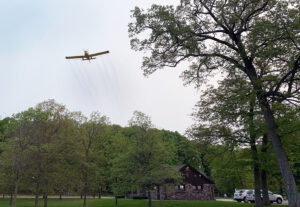
An airplane sprays pesticide over trees at Devils Lake State Park in Sauk County to help in the control of spongy moth caterpillars. / Photo Credit: Sue Johansen, Wisconsin DNR
By Art Kabelowsky, DNR Outreach and Communications
Arthur.Kabelowsky@wisconsin.gov or 608-335-0167
The Wisconsin Department of Natural Resources (DNR) has finalized aerial spraying plans for its 2025 Spongy Moth Suppression Program, with maps for the five selected treatment areas available online.
The treatment sites are at three state parks in Juneau, Marinette and Sauk counties that are highly valued for their recreational use. A total of 544 acres of trees will be treated with an aerial spray of “Foray” bacterial insecticide containing Bacillus thuringiensis var. kurstaki.
Areas to be sprayed:
| Location | County | Spray Block Acres | Spraying Over Campground? |
| Rocky Arbor State Park | Juneau | 85 | Yes |
| Gov. Thompson State Park | Marinette | 212 | Yes |
| Gov. Thompson State Park | Marinette | 40 | No |
| Mirror Lake State Park | Sauk | 187 | Yes |
| Mirror Lake State Park | Sauk | 20 | No |
The aerial spraying will occur between early May and early June, with exact dates and times dependent upon caterpillar development and weather conditions. The DNR intends to avoid spraying high-use properties during the extended Memorial Day weekend if spraying has not occurred by that weekend.
For up-to-date information, visit the Wisconsin Spongy Moth Resource Center and subscribe to email updates that will provide notice when spraying dates are determined. Also, the toll-free Spongy Moth Hotline, 800-642-MOTH (800-642-6684), has a recording of up-to-date spraying plans. Law enforcement, local governments, schools and nearby medical facilities will be notified before spraying.
The DNR aerial spray program complements the Wisconsin Department of Agriculture, Trade and Consumer Protection’s (DATCP) participation in the national “Slow the Spread” program. DATCP airplanes will treat sites in nine western counties. The program was created to slow the westward spread of spongy moth by treating newly established, low-level populations in areas not infested by this pest.
DATCP’s planned 2025 spray blocks also have been selected, and the DATCP spray block book maps are also available online.
“Slow the Spread” treatments will use either the same insecticide as the DNR treatments or a pheromone mating disruptor that prevents moth reproduction by interfering with the ability of male moths to find female moths. Insecticide spraying will take place in spring; mating disruption spraying will take place in summer. Learn more in DATCP’s news release.
Please note that the state of Wisconsin does not offer a state-sponsored or cost-share program for treating private property to prevent defoliation by spongy moth. Those interested in organizing a spray program at their own expense can view a DNR guide titled “Organizing An Aerial Spray For Forest Pests.” Landowners may also hire tree-care businesses to apply insecticide from the ground. Management options can be viewed online through the Wisconsin Spongy Moth Resource Center.
Spongy moth caterpillars feed on many tree and shrub species, stripping trees of their leaves and potentially killing them. Spongy moth outbreaks occur every five to 10 years. In 2023, Wisconsin saw a record amount of spongy moth defoliation, with about 375,000 acres affected (mostly in northern Wisconsin).
Last year, the spongy moth population was significantly reduced by viral and fungal infections that affect the caterpillars.
Generally, healthy hardwoods can endure one or two years of heavy defoliation before tree mortality occurs. Healthy trees typically put out a replacement set of leaves a few weeks after defoliation. However, this uses energy reserves and makes the tree more susceptible to disease, drought stress and other insect attacks, which, in combination, can kill the trees.
